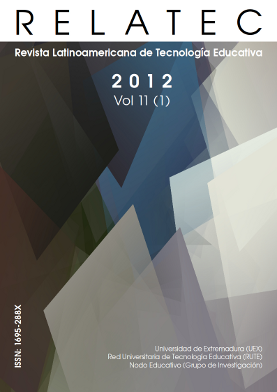Redes sociales y microblogging: innovación didáctica en la formación superior
Keywords:
Medios de enseñanza, TIC, Formación de profesores, Aprendizaje social, Medios de comunicación de masas, Innovación pedagógica.Abstract
Cada día nacen nuevos sitios web destinados a crear y gestionar redes sociales, a crear grupos o comunidades, a mantener el contacto online con personas conocidas o con los conocidos de estos últimos, a compartir conocimiento, experiencias, música, fotografías, entre otros. Estamos viviendo un gran fenómeno social que está revolucionando la manera de comunicarse y de interactuar con los demás, puesto que se están originando nuevas formas de interacción social, hasta ahora jamás producidas, donde se desencadena una red de contactos e intercambio virtual y dinámico entre personas, grupos e instituciones que tienen intereses y necesidades comunes (Bettinson, 2009; Espuny et al., 2011). Este fenómeno es provocado principalmente por las llamadas «redes sociales virtuales y el microblogging». Pero, ¿qué son exactamente las redes sociales virtuales?, ¿qué las diferencia de las redes sociales meramente físicas?, ¿qué ventajas e inconvenientes puede conllevar su uso? y por supuesto, ¿cómo podemos aprovechar esas ventajas en los diferentes contextos formativos?. En este artículo se presentan distintas experiencias educativas realizadas por tres docentes de la Facultad de Formación del Profesorado de la Universidad de Extremadura, que puede servir como marco de reflexión y acción en la praxis e innovación educativa que pueden servir de reflexión, ejemplo o de punto de partida para todo aquel docente que busque en las redes sociales la oportunidad de innovar en su práctica educativa.
Nowadays, new websites are created everyday. They are devoted to creating and managing social networks, create groups or communities, to keep online contact with acquaintances and the acquaintances of the latter, to share knowledge, experiences, music, photographs, etc. Thus, we are witnessing a great social phenomenon, a true revolution in the way of communicating and interacting with others, owing to the fact that new modes of social interaction, unknown before, are emerging, whereby new networks of contacts and virtual and dynamic exchanges surge among individuals, groups and institutions sharing common interests and needs (Bettinson, 2009; Espuny et al., 2011). This phenomenon is mainly triggered by the so called «virtual social networking and microblogging». However, what exactly are virtual social networks?; what is it that differenciate them from mere physical social networks?; what are the advantages and drawbacks their use can entail?, and above all, how can we make the most of them in regular and virtual teaching? Hereby will be explained different teaching experiences carried out by three lecturers from the University of Extremadura that should serve as a reflexion, experience sharing or starting point for those practitioners that are looking for innovation in the social networking area.
Downloads
Downloads
Published
Issue
Section
License
Authors who publish in this journal accept the following conditions:
1. The Author retains copyright in the article. Upon acceptance of the article, the author shall grant to the Publisher the right of first publication of the article. with the dcoument registered with the Creative Commons Attribution-NonCommercial-NoDerivative 4.0 International (CC BY-NC-ND) license, which allows to third parties to use what is published whenever they mention the authorship of the work and the first publication in this journal.
2. Authors can make other independent and additional contractual agreements for the non-exclusive distribution of the article published in this journal (eg, include it in an institutional repository or publish it in a book) provided they clearly indicate that the work was published for the first time in this journal.
3. Authors are allowed and recommended to publish their work on the Internet (for example on institutional or personal pages) before and during the review and publication process, as it can lead to productive exchanges and a greater and faster diffusion of published work (see The Effect of Open Access).









